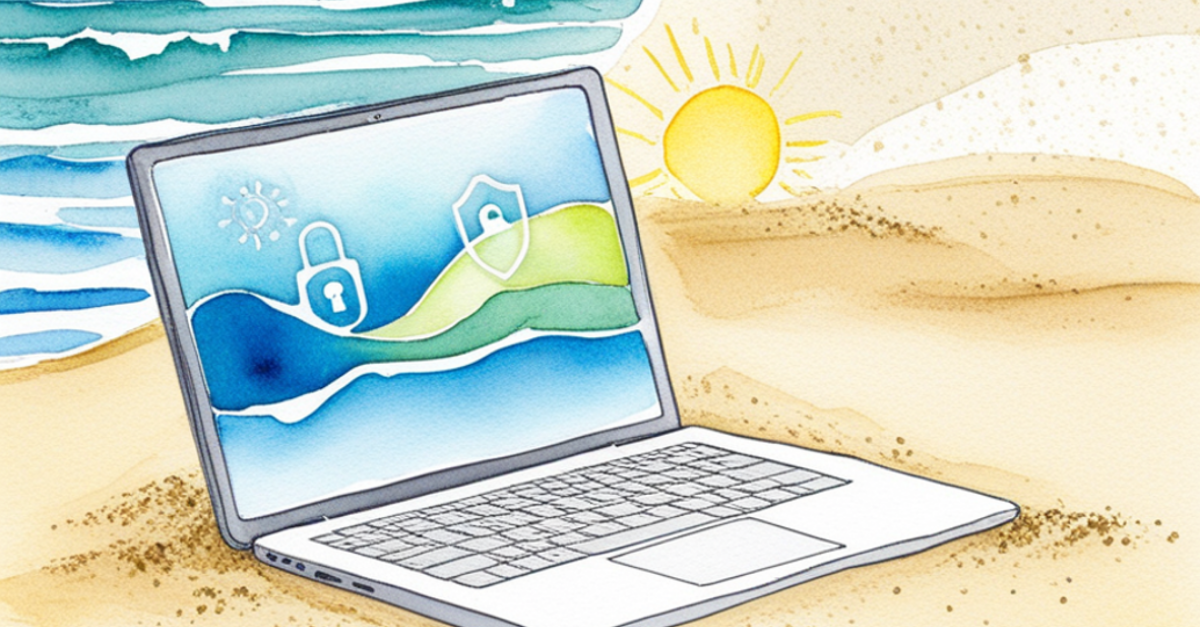Summer is just around the corner—and here in the Midwest, that means people are eager to make the most of the short warm season.

As vacation plans take shape, many employees will be working on the go, checking email from the cabin, hopping on a quick video call at the airport, or logging in from hotels and coffee shops.
But without proper remote work security, doing so can put your organization at risk. Wherever work happens this summer, it’s important not to leave security best practices behind.
Here are a few practical IT security tips to help your organization stay secure when employees work remotely.
1. Use Caution When Using Public Wi-Fi
43% have had their online security compromised while using public Wi-Fi. That’s a number we all need to take seriously.
Public networks may be convenient—but they can be unsecure and vulnerable to attack. Bad actors can easily connect to these networks and exploit vulnerabilities (also known as man-in-the-middle (MITM) attacks) to secretly steal sensitive data or install malicious software on your device.
If avoiding public Wi-Fi is not possible, the best way to protect yourself is to connect to it through a trusted virtual private network (VPN). A VPN encrypts your traffic so that hackers cannot easily access the data sent between your device and the router.
It’s important to note that VPNs are not a complete security solution, and they can still be compromised. We recommend still avoiding sites that require you to enter personal information such as credit card numbers while on a public network.
2. Implement Multi-Factor Authentication (MFA)
Multi-Factor Authentication (MFA) adds an extra layer of protection beyond just a username and password. It requires users to verify their identity with a second factor, such as a code from an app or a physical token, to make it harder for unauthorized users to gain access.
MFA can be enabled on a wide range of systems, including email, VPNs, computer logins, cloud applications, and financial accounts. Wherever it’s available, turning it on is a simple way to reduce the risk of a breach.
3. Prepare for Lost or Stolen Devices (and Manage Them Remotely)
It can be easy to leave a laptop behind or misplace a phone, especially during travel. A lost device can be a treasure trove of information, especially if it ends up in the wrong hands.
That’s why strong endpoint management is essential. Solutions like Mobile Device Management (MDM) and Embedded Endpoint Security Management gives IT teams centralized control over laptops, tablets, phones and other devices, both in the office and remote.
With the right solution in place, your team can:
- Remotely locate, lock or wipe lost or stolen devices
- Enforce security policies
- Monitor usage
- Detect suspicious activity
- Isolate compromised devices before damage spreads
4. Avoid Public USB Charging Stations
You’ve probably seen USB charging ports built into airport seats or hotel lamps. What you may not know is that USB ports can transfer data as well as power. If a port is compromised, simply plugging in could install malware on your device or allow data to be copied without your knowledge.
If you need to charge your devices while on the go, use a wall outlet with your own charger instead of a USB port. You can also carry a USB data blocker, which allows power to flow but blocks data transmission.
5. Use a Privacy Screen in Public Spaces
Installing malware isn’t the only way for someone to steal your data, sometimes all it takes is a curious person in the seat next to you. A privacy screen is a simple and affordable way to limit the viewing angle of your laptop or tablet, making it difficult to read from the side.
If you’re working with customer records, financial data, or anything confidential in public, a privacy screen is essential.
6. Stay Alert for Phishing While Away
Hackers know people let their guard down during time off, and they take advantage of it. Whether it’s an unexpected password reset or a fake “trip confirmation” email, phishing attempts often spike during peak travel months.
Always be cautious with links and attachments, especially if the message feels urgent or is unexpected. When in doubt, verify the request through another communication channel before responding.
Also, be mindful of what you share online. Publicly posting vacation details can unintentionally put both your physical and digital security at risk.
Stay Secure Wherever Work Takes You
Security doesn’t stop when you leave the office. As you and your team travel this summer, a few extra precautions like using a VPN, enabling MFA, and applying device-level protections can make all the difference.
If you’d like help reviewing your current security tools or remote work security policies, our team is here to support you. Talk to a WIN specialist to learn more.
